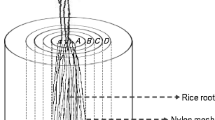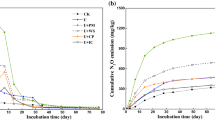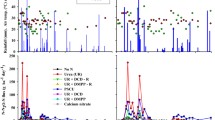Abstract
Representing an important greenhouse gas, nitrous oxide (N2O) emission from cultivated land is a hot topic in current climate change research. This study examined the influences of nitrogen fertilisation, temperature and soil moisture on the ammonia monooxygenase subunit A (amoA) gene copy numbers and N2O emission characteristics. The experimental observation of N2O fluxes was based on the static chamber-gas chromatographic method. The ammonia-oxidising bacteria (AOB) and ammonia-oxidising archaea (AOA) gene copy numbers in different periods were measured by real-time polymerase chain reaction (PCR). The results indicated that rain-fed potato field was a N2O source, and the average annual N2O emission was approximately 0.46 ± 0.06 kgN2O-N/ha/year. N2O emissions increased significantly with increase in fertilisation, temperatures below 19.6 °C and soil volumetric water content under 15%. Crop rotation appreciably decreases N2O emissions by 34.4 to 52.4% compared to continuous cropping in rain-fed potato fields. The significant correlation between N2O fluxes and AOB copy numbers implied that N2O emissions were primarily controlled by AOB in rain-fed potato fields. The research has important theoretical and practical value for understanding N2O emissions from rain-fed dry farmland fields.





Similar content being viewed by others
References
Avrahami S, Conrad R (2003) Patterns of community change among ammonia oxidizers in meadow soils upon long-term incubation at different temperatures. Appl Environ Microbiol 69(10):6152–6164
Ball BC (2013) Soil structure and greenhouse gas emissions: a synthesis of 20 years of experimentation. Eur J Soil Sci 64(3):357–373
Barton L, Kiese R, Gatter D et al (2008) Nitrous oxide emissions from a cropped soil in a semi-arid climate. Glob Chang Biol 14(1):177–192
Bouwman AF, Boumans LJM, Batjes NH (2002) Emissions of N2O and NO from fertilized fields: summary of available measurement data. Glob Biogeochem Cycles 16(4):1058
Castaldi S (2000) Responses of nitrous oxide, dinitrogen and carbon dioxide production and oxygen consumption to temperature in forest and agricultural light-textured soils determined by model experiment. Biol Fertil Soils 32(1):67–72
Chen XP, Zhu YG, Xia Y et al (2008) Ammonia-oxidizing archaea: important players in paddy rhizosphere soil? Environ Microbiol 10(8):1978–1987
Chen GC, Tam NFY, Ye Y (2010) Summer fluxes of atmospheric greenhouse gases N2O, CH4 and CO2 from mangrove soil in South China. Sci Total Environ 408(13):2761–2767
Chirinda N, Olesen JE, Porter JR et al (2010) Soil properties, crop production and greenhouse gas emissions from organic and inorganic fertilizer-based arable cropping systems. Agric Ecosyst Environ 139(4):584–594
Derveaux S, Vandesompele J, Hellemans J (2010) How to do successful gene expression analysis using real-time PCR. Methods 50(4):227–230
Di HJ, Cameron KC, Shen JP et al (2009) Nitrification driven by bacteria and not archaea in nitrogen-rich grassland soils. Nat Geosci 2(9):621–624
Di HJ, Cameron KC, Shen JP et al (2010) Ammonia-oxidizing bacteria and archaea grow under contrasting soil nitrogen conditions. FEMS Microbiol Ecol 72(3):386–394
Fierer N, Schimel JP (2003) A proposed mechanism for the pulse in carbon dioxide production commonly observed following the rapid rewetting of a dry soil. Soil Sci Soc Am J 67(3):798–805
Francis CA, Roberts KJ, Beman JM et al (2005) Ubiquity and diversity of ammonia-oxidizing archaea in water columns and sediments of the ocean. Proc Natl Acad Sci U S A 102(41):14683–14688
Gregorich EG, Rochette P, VandenBygaart AJ et al (2005) Greenhouse gas contributions of agricultural soils and potential mitigation practices in Eastern Canada. Soil Tillage Res 83(1):53–72
Hermansson A, Lindgren PE (2001) Quantification of ammonia-oxidizing bacteria in arable soil by real-time PCR. Appl Environ Microbiol 67(2):972–976
Horz HP, Barbrook A, Field CB et al (2004) Ammonia-oxidizing bacteria respond to multifactorial global change. Proc Natl Acad Sci U S A 101(42):15136–15141
Hou XY, Wang FX, Han JJ et al (2010) Duration of plastic mulch for potato growth under drip irrigation in an arid region of Northwest China. Agric For Meteorol 150(1):115–121
Hu Q, Pan FF, Pan XB (2014) Effects of a ridge-furrow micro-field rainwater-harvesting system on potato yield in a semi-arid region. Field Crop Res 166:92–101
IPCC (2007) Climate change: the physical science basis: contribution of working group I to the fourth assessment report of the intergovernmental panel on climate change. Cambridge University Press, Cambridge, pp. 539–542
Kool DM, Dolfing J, Wrage N et al (2011) Nitrifier denitrification as a distinct and significant source of nitrous oxide from soil. Soil Biol Biochem 43(1):174–178
Kowalchuk GA, Stephen JR (2001) Ammonia-oxidizing bacteria: a model for molecular microbial ecology. Annual Reviews in Microbiology 55(1):485–529
McSwiney CP, Robertson GP (2005) Nonlinear response of N2O flux to incremental fertilizer addition in a continuous maize (Zea mays L.) cropping system. Glob Chang Biol 11(10):1712–1719
Meijide A, Díez JA, Sánchez-Martín L et al (2007) Nitrogen oxide emissions from an irrigated maize crop amended with treated pig slurries and composts in a Mediterranean climate. Agric Ecosyst Environ 121(4):383–394
Mkhabela MS, Gordon R, Burton D et al (2006) Ammonia and nitrous oxide emissions from two acidic soils of Nova Scotia fertilised with liquid hog manure mixed with or without dicyandiamide. Chemosphere 65(8):1381–1387
Morley N, Baggs EM, Dörsch P et al (2008) Production of NO, N2O and N2 by extracted soil bacteria, regulation by NO2 − and O2 concentrations. FEMS Microbiol Ecol 65(1):102–112
Nielsen DC, Vigil MF (2005) Legume green fallow effect on soil water content at wheat planting and wheat yield. Agron J 97(3):684–689
Okano Y, Hristova KR, Leutenegger CM et al (2004) Application of real-time PCR to study effects of ammonium on population size of ammonia-oxidizing bacteria in soil. Appl Environ Microbiol 70(2):1008–1016
Olibone D, Encide-Olibone AP, Rosolem CA (2010) Least limiting water range and crop yields as affected by crop rotations and tillage. Soil Use Manag 26(4):485–493
Purkhold U, Pommerening-Röser A, Juretschko S et al (2000) Phylogeny of all recognized species of ammonia oxidizers based on comparative 16S rRNA and amoA sequence analysis: implications for molecular diversity surveys. Appl Environ Microbiol 66(12):5368–5382
Reay DS, Davidson EA, Smith KA et al (2012) Global agriculture and nitrous oxide emissions. Nat Clim Chang 2(6):410–416
Rotthauwe JH, Witzel KP, Liesack W (1997) The ammonia monooxygenase structural gene amoA as a functional marker: molecular fine-scale analysis of natural ammonia-oxidizing populations. Appl Environ Microbiol 63(12):4704–4712
Sauerborn J, Sprich H, Mercer-Quarshie H (2000) Crop rotation to improve agricultural production in Sub-Saharan Africa. J Agron Crop Sci 184(1):67–72
Schaufler G, Kitzler B, Schindlbacher A et al (2010) Greenhouse gas emissions from European soils under different land use: effects of soil moisture and temperature. Eur J Soil Sci 61(5):683–696
Schleper C, Jurgens G, Jonuscheit M (2005) Genomic studies of uncultivated archaea. Nat Rev Microbiol 3(6):479–488
Shen J, Zhang L, Zhu Y et al (2008) Abundance and composition of ammonia-oxidizing bacteria and ammonia-oxidizing archaea communities of an alkaline sandy loam. Environ Microbiol 10(6):1601–1611
Skiba U, Drewer J, Tang YS et al (2009) Biosphere–atmosphere exchange of reactive nitrogen and greenhouse gases at the NitroEurope core flux measurement sites: measurement strategy and first data sets. Agric Ecosyst Environ 133(3):139–149
Stocker T F, Qin D, Plattner G K, et al. (2013) IPCC, 2013: climate change 2013: the physical science basis. Contribution of working group I to the fifth assessment report of the intergovernmental panel on climate change.
Tellez-Rio A, García-Marcoa S, Navas M et al (2015) N2O and CH4 emissions from a fallow–wheat rotation with low N input in conservation and conventional tillage under a Mediterranean agroecosystem. Sci Total Environ 508:85–94
Wang LW, An PL, Pan ZH et al (2013) Cultivated land quality change of Wuchuan county in Inner Mongolia under background of climate change in semi-arid regions during recent 20 years. Transactions of the Chinese Society of Agricultural Engineering 29(11):224–231
Welzmiller JT, Matthias AD, White S et al (2008) Elevated carbon dioxide and irrigation effects on soil nitrogen gas exchange in irrigated sorghum. Soil Sci Soc Am J 72(2):393–401
Werner C, Zheng X, Tang J et al (2006) N2O, CH4 and CO2 emissions from seasonal tropical rainforests and a rubber plantation in Southwest China. Plant Soil 289(1–2):335–353
Wuebbles DJ (2009) Nitrous oxide: no laughing matter. Science 326(5949):56–57
Xu Y, Cai Z, Xu Z (2012) Production and consumption of N2O during denitrification in subtropical soils of China. J Soils Sediments 12(9):1339–1349
Ying JY, Zhang LM, He JZ (2010) Putative ammonia-oxidizing bacteria and archaea in an acidic red soil with different land utilization patterns. Environ Microbiol Rep 2(2):304–312
Yuan M, Zhang L, Gou F et al (2013) Assessment of crop growth and water productivity for five C3 species in semi-arid Inner Mongolia. Agric Water Manag 122:28–38
Zheng X, Wang M (1997) Impacts of temperature on N2O production and emission. Chinese Journal of Environmental Science 18:1–5
Acknowledgements
This research was funded by the National Non-profit Research Foundation for Agriculture (201103039), the National Natural Science Foundation of China (Grant Nos. 41371232 and 41271110), the National Basic Research Program of China (No. 2012CB956204) and the National Science and Technology Support Program of China (No. 2012BAD09B02). The authors would like to extend their thanks and appreciation to the staff at the Key Ecological and Environmental Scientific Experiment and Field Observation Station of the Chinese Ministry of Agriculture for assisting in all experiments.
Author information
Authors and Affiliations
Corresponding author
Rights and permissions
About this article
Cite this article
Wang, L., Wang, C., Pan, Z. et al. N2O emission characteristics and its affecting factors in rain-fed potato fields in Wuchuan County, China. Int J Biometeorol 61, 911–919 (2017). https://doi.org/10.1007/s00484-016-1271-3
Received:
Revised:
Accepted:
Published:
Issue Date:
DOI: https://doi.org/10.1007/s00484-016-1271-3




